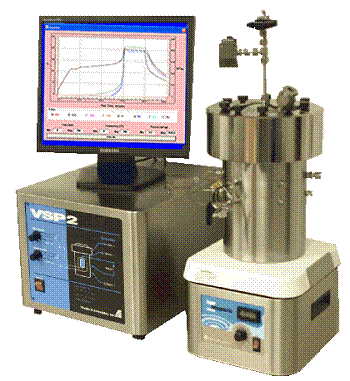 Vent Sizing Package 2 (VSP2™)
Vent Sizing Package 2 (VSP2™)
Background
Fauske & Associates, LLC’s (FAI) Vent Sizing Package 2™ (VSP2™) is a low thermal inertia adiabatic calorimeter used for process hazard characterization that utilizes state-of-the-art DIERS technology to obtain critical upset process design data. It is the commercial version of the original DIERS bench scale apparatus. At FAI, we not only utilize the VSP2TM in our fully equipped hazards laboratory but we also manufacture and sell the calorimeter for use by our clients

Its versatile and innovative design allows the VSP2TM to simulate upset (abnormal) conditions which might lead to a runaway chemical reaction (e.g. loss of cooling, loss of stirring, mischarge of reagents, mass-loaded upset, batch contamination, fire exposure heating, etc). Resulting temperature and pressure rise rates are directly scalable since it is a low thermal inertia (phi-factor) apparatus.
The VSP2TM typically utilizes a sample size of 40-100 grams in a lightweight metal test cell with a volume of approximately 120 ml. The test cell is surrounded by a heater which is used to maintain adiabiatic conditions during an experiment. This test cell and heater assembly is placed in a 4L containment vessel. Test are typically performed as a closed system, so that vapor pressure data can be measured.
Benefit
The VSP2TM utilizes established DIERS technology to identify and quantify process safety hazards so they can be prevented or accommodated by process design. Test data includes adiabatic rates of temperature and pressure change which, due to the low thermal inertia, can be directly applied to process scale to determine relief vent sizes, quench tank designs and other relief system design parameters related to process safety management. Adiabatic data obtained with the VSP2TM can be used to characterize reactive chemical systems and consequences that could occur due to process upset conditions
Features
The versatile configurations offered by the VSP2TM design directly simulates process conditions including:
- Loss of cooling or agitation
- Accumulation or mischarge of reactants
- Contamination of batch
- Thermally initiated decomposition
- Resident incubation time
- In-situ liquid/gas dosing or sampling
- Many testing configurations
– Solids, liquids or two phase mixtures
– Closed or open (vented) tests
– Scaled blowdown simulation
– Test cells are available in 304 & 316 SS, Hastelloy C, Titanium and glass
Applications
Use of the VSP2TM can help users obtain complete chemical system data such as:
- Low thermal inertia testing allows data to be directly applied to process scale
- Temperature and pressure rise rates applicable to relief system design “Based on DIERS two-phase flow technology, recognized by OSHA as an example of “good engineering practice”
- Critical temperature (aka onset temperature)
- Total adiabatic temperature rise (ΔTad)
- Heat of reaction or mixing
- Vapor pressure data
- Time to maximum rate (tmr)
- Self-accelerating decomposition temperature (SADT)
- Vent sizing
- Quench tank design
- Effluent handling
- Blowdown testing for two-phase flow determination
FAI has also created the PrEVent software to allow users to implement practical emergency vent sizing using industry recognized methodology. It applies DIERS methodology (including the Leung-Omega and Fauske methods) for reactive chemistry and API 520/2000 or NFPA 30 for non-reactive systems.